When you think of Bavaria, Germany the last thing you would think of is Armenia or anything related to it.

House of Wittelsbach
According to a legend, the principality of Bavaria starts with the expulsion of an Armenian prince named Bavarus and his people from their homeland. At this time in history the occupation of Armenia by the Romans under Pompeius (1st century B.C.) forced Bavarus and his people to leave Armenia.
A study of literary activity at the court of Munich by Andrea Klein, tells us about a myth regarding the dynasty of Wittelsbach, who trace their lineage to a supposed Armenian ancestor named Bavarus. Bavarus managed to unite his people with the native tribe of Norix, bringing law and peace to his new homeland.
It is said that his sense of justice helped Bavarus to win the trust of his new subjects. After Norix’s death Bavarus ruled over ´Bavaria´ alone and conferred his name upon his territory. He also incorporated Osterfrancken, Kerlingen, Burgund, Oesterreich, Isterreich and Merhern into his lands. Bavarus became the first duke of the Duchy of Bavaria.

The Annolied
The legend that the Bavarians came from Armenia and that their land was later conquered by Norix, the leader of his tribe, who was mentioned as the son of Hercules, makes its first appearance in written form in the Annolied. The Annolied “Song of Anno” is a poem composed around the year 1100 AD by a monk named Siedburg Abbey, praising Bishop Anno II of Cologne.

The poem includes a typical medieval “origo gentis” (origin) story about four German peoples:
- The Bavarians;
- The Franks
- The Saxons
- The Thuringians
The Annolied is hereby the first text to give a popular motif whereby the ancestors of the Bavarians migrated from Armenia:
Duo sich Beirelant wider in virmaz, Die mêrin Reginsburch her se bisaz, Dâ vanter inne Helm unti brunigen, Manigin helit guodin, Die dere burg hû[h]din. Wiliche Knechti dir wêrin, Deist in heidnischin buochin mêri. Dâ lisit man Noricus ensis, Daz diudit ein suert Beierisch, Wanti si woldin wizzen Daz inge[m]ini baz nibizzin, Die man dikke durch den helm slûg; Demo liute was ie diz ellen gût. Dere geslehte dare quam wîlin êre Von Armenie der hêrin, Dâ Nôê ûz der arkin gîng, Dûr diz olizuî von der tûvin intfieng: Iri zeichin noch du archa havit Ûf den bergin Ararat. Man sagit daz dar in halvin noch sîn Die dir Diutischin sprecchin, Ingegin India vili verro. Peiere vûrin ie ziwîge gerno: Den sigin den Cêsar an un gewan Mit bluote mûster in geltan.
A second source, an anonymous Monk from Göttweig tells an invasion story of Bavarians invading Göttweig as follows:
It is situated in Noricum Ripense. Hence we pass the provenance of the Bavarians, who came from Armenia and invaded the land under their leader Bavarus, driving out the natives. Norix, son of Hercules, conquered it “after many days” and called it after his name. Here he founded the city Tiburtina, which is now Ratisbon.
These sources seem to be mythologizing Bavarian history. It is possible that Bavarus was an Armenian and that there is truth to the legend. However, we must also consider the possibility that the story can be just a legend. During the times of these authors, it was fashionable to connect German Peoples and their history to antiquity.
As for the House of Wittelsbach to claim Armenian ancestry through Bavarus, would help them boost their profile and strengthen their hereditary right to rule. However interesting, written sources about Bavarus are limited and mythologized. In addition, the written sources that are available only came into existence over a thousand years after the suggested arrival of the Bavarians. The exact details and facts still remain a mystery, however, they are also fascinating.
Written by
Hovik Torkomyan, B Comn
Founder History of Armenia
Source:
- Dahlem, A. M. PhD. (2009). The Wittelsbach Court in Munich: History and Authority in the Visual Arts (1460-1508). Retrieved from http://theses.gla.ac.uk/892/1/2009dahlemphd_edited.pdf
- Authority in European Book Culture 1400-1600. P. Bromilow. p. 88-89.
- Studies in Medieval Thought and Learning From Abelard to Wyclif. Beryl Smalley, p. 11.
- Pius 2nd, “el Più Expeditivo Pontefice”. Edited by Zweder R. W. M. von Martels, Arie Johan Vanderjagt, p. 70.


Please keep me updated.
Regards ED